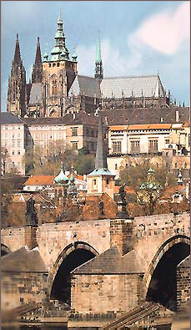 This wish turned out to be reality in Prague, despite the city having been discovered by the tourist crowds. I must admit that most guidebooks include only the briefest of references to the Sternberg Palace, which has a distinctly unobtrusive sign affixed to it to the effect that it houses some National Collection or other, while classifications such as National Museum and National Gallery are used in a most confusing manner, with constituent collections having been housed elsewhere, but then we are talking about three cavernous storeys crammed with paintings, from early Medieval times and before to the late 20th century. Although many of the paintings are dirty and neglected and the lighting is generally poor, it gives you the feeling of single-handedly unearthing your very own Old Masters. Not that you are truly on your own: a staunch gaggle of sturdy-looking lady attendants who have decided that enough's enough outnumber the visitors, but it's as close as you will ever get to experiencing the "Fuchs Ideal". Not that it was a smooth undertaking. The attendants followed me closely, continually debating whether or not to reprimand me whenever I moved in on a painting to study a detail. Keeping my hands clasped behind my back didn't seem to make much difference. Whenever I retraced my steps to take another look at a painting by Cranach or Ter Borch, at least two attendants sprung into action, shadowing my every move. In fact, there was one occasion on which they nabbed me. One enters the various rooms by opening the relevant door - something you will find in no other museum in the whole wide world. The door in question was very old, and after I had closed it, I carefully looked at it and briefly touched it. This triggered a reprimand. Let's recap here: I opened a door, went through it and carefully closed it. By studying what had until then been an object of use, I caused this very door to transform, within less than five seconds, into a priceless antique which it was strictly forbidden to touch. Another remarkable collection of paintings can be seen a mere stone's throw away from the Sternberg Palace. There are a few more visitors, but not very many. On entering the Prague Castle, a sign can be spotted in the distance to the left, bearing the legend "The Prague Castle Gallery". Which I'll grant you doesn't have a terribly authentic ring to it, but just try to pronounce this: Obrazárna Prazského Hradu. Here too you will find a cornucopia of wonderful paintings, except that these are properly varnished. The "Fuchs Ideal" is a little less obvious here. The tour continues. There are two churches on the site of Prague Castle, the Saint Vitus Cathedral (Gothic) and the Saint George Basilica (Roman) - absolutely splendid buildings, both of them. In between there's all kinds of other things to admire. One saunters along chatting and suddenly, without any advance warning, finds oneself in an entirely empty room 62 metres in length by 13 metres wide. Nothing on the walls, nothing on the floor, hardly anybody in it - it's the room itself, the space and the way in which it is confined. I am absolutely sure that Ronald de Leeuw will never make a statement like Fuchs's, but I'm not accountable to anyone, so I can use this space to tell you how impressive this emptiness manifested itself to me, not bearing repetition, realisable nowhere else in the world, even more incomprehensible - the building defies comparison with the 15th-century Vladislaw Room, but what I'm driving at is to find words to describe the indescribable in the form of an incomparable comparison - than an utterly empty Rijksmuseum. |